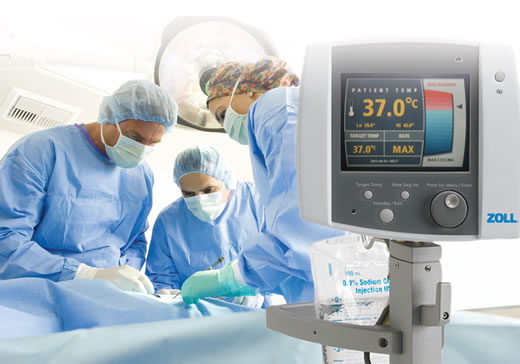A limited time window to administer therapy for ischemic stroke means every second counts. Now doctors may be able to slow down the hands of time in this critical time frame by using hypothermia - cooling the body to halt reperfusion injury of brain tissue.
This year close to 800,000 Americans will experience ischemic stroke, which occurs when a brain artery is blocked. It’s the fourth leading cause of death and the first leading cause of disability in the U.S. because brain tissue not only dies when blood flow is interrupted, it’s also injured immediately after the brain artery is re-opened - what is called "reperfusion" injury.
Neurology and neurosurgery researchers from Emory University School of Medicine presented results of the Endovascular Reperfusion and Cooling in Cerebral Acute Ischemia (ReCCLAIM I) study at the American Heart Association-American Stroke Association’s 2013 International Stroke Conference in Hawaii earlier this month.
Hypothermia has been induced therapeutically for centuries. It’s believed Hippocrates advocated packing wounded soldiers in snow and ice. Today, hypothermia is a proven "neuro-protectant" in patients with cerebral ischemia following cardiac arrest.
In the ReCCLAIM I clinical trial, researchers induced hypothermia to halt or at least slow the loss of brain cells in patients who had a stroke and underwent removal of the blockage at the site of the brain artery involved. The purpose of the study was to determine the safety of using hypothermia in this setting.
"tPA - tissue plasminogen activator -- is the standard of care for treatment of acute ischemic stroke, and it’s used to dissolve a blood clot," says Christopher Horn, MD, assistant professor of neurology and neurosurgery at Emory School of Medicine and senior investigator for ReCCLAIM I.
"However, in patients who are experiencing a severe stroke caused by a large blood clot, there is a very low likelihood that they will regain blood flow immediately after tPA is given. So our next course of action is immediate removal of the blockage at the site of the involved artery. Unfortunately, what recent trials have shown us is that even if we can open up a majority of arteries it doesn’t always translate into better outcomes."
While the reason for these divergent results is likely multi-faceted, Horn and his colleagues from the Marcus Stroke and Neuroscience Center at Grady Memorial Hospital believe reperfusion injury is a major cause and may be treatable with hypothermia.
ReCCLAIM I enrolled 20 patients averaging 59 years of age in the study between May and August 2012. All patients had very severe strokes and were treated in less than eight hours from stroke onset with removal of the clot from the brain artery (endovascular reperfusion) and then immediately placed into hypothermia with the use of a catheter that cools the body from the inside out. Hypothermia was maintained at a target temperature of 91o Fahrenheit for 12 hours.
"When we compared the patients that underwent hypothermia to previously treated patients who had similar severe strokes and did not undergo hypothermia, we saw that there was a significant difference in what we consider reperfusion injury and an overall trend to better outcomes" says Horn. "There is some evidence to suggest that hypothermia is protective."
According to Horn, ReCCLAIM I is different from the way hypothermia has been used previously for ischemic stroke. "Hypothermia has only been successful in helping patients who have had cardiac arrest because these patients have blood flow re-established to their brains. Without definitively re-establishing blood flow to patient’s brains, there is less likelihood that hypothermia would be of any help."
Horn and colleagues are preparing for ReCCLAIM II, an investigator-initiated, randomized, controlled clinical trial expected to start this year, comparing use of hypothermia to normal temperatures. "Phase 2 will include 85 patients from Grady Memorial Hospital and University of Pittsburgh Medical Center, and will provide more definitive research on the true safety and impact of using hypothermia," says Horn.

